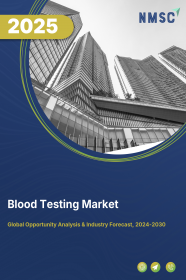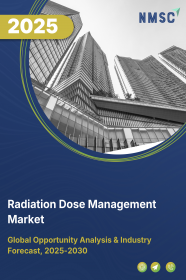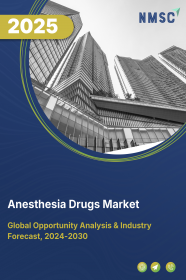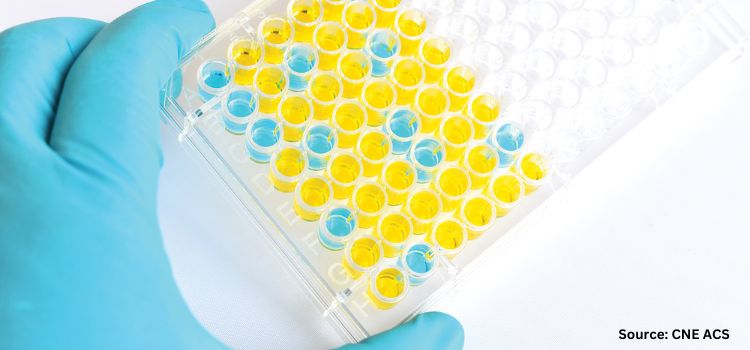
Blood Testing Market by Test Type (Lipid, A1C, CRP, Vitamin D, BUN, Glucose, ALT, AST, TSH, PSA, Cortisol, Creatinine, Direct LDL, and Testosterone), by Product & Services (Reagent & Kit, Software & Services, and Instruments), by Technology (Nucleic Acid Test, Western Blot Assays, and Next-generation Sequencing), by Method (Automated and Manual), by Disease (Anemia, Infection, and Leukemia), and by End User – Global Opportunity Analysis and Industry Forecast, 2024–2030
US Tariff Impact on Blood Testing Market
Trump Tariffs Are Reshaping Global Business
Market Definition
The global Blood Testing Market size was valued at USD 91.31 billion in 2023 and is predicted to reach USD 147.61 billion by 2030 with a CAGR of 7.1% from 2024 to 2030.
Blood tests are used to measure or examine cells, chemicals, proteins, or other substances in the blood. These are also carried out to identify presence or development of a particular disease or medical condition in the body. The most common blood test is the complete blood count (CBC), which is performed as part of a routine check-up by a doctor. This test measures different components of blood such as red blood cells, white blood cells, and platelets.
Market Dynamics and Trends
Rise in demand for blood testing is attributed to increase in incidences of various diseases such as thyroid, Human Immunodeficiency Virus (HIV), genetic disorders, bacterial and viral allergic disorders, and hepatitis. Rise in global awareness regarding the need for safe blood for transfusion by various international organizations such as the United Nations Organization and Global Health Organization and governments also propels the market growth.
For instance, each year Global Blood Donor Day is celebrated on 14 June by the Global Health Organization and governments across regions. The day is celebrated to raise global awareness regarding the need for safe blood and blood products for transfusion. In addition, growth in patient awareness regarding home diagnostic tests and self-testing blood kits such as the Omega-3 Index are expected to further propel the blood testing market growth during the forecast period.
However, high cost of automated blood testing and lack of awareness regarding latest advancements restrain growth of the market during. On the contrary, rise in use of glucometers with technological advancements such as wireless connectivity and Bluetooth, such as contour next one meter, OneTouch Verio Flex meter, and iHealth Smart Wireless Gluco-Monitoring System are expected to create ample growth opportunities for the market in the coming years.
Market Segmentation and Scope of the Study
The global blood testing market report is segmented on the basis test type, product & services, technology, method, disease, end user, and geography. On the basis of test type, the market is categorized into lipid, A1C, CRP, vitamin d, BUN, glucose, ALT, AST, TSH, PSA, cortisol, creatinine, direct LDL, and testosterone. On the basis of product & services, it is divided into reagent & kits, software & services, and instrument.
The reagents & kits are sub-segmented into NAT reagents & kits, ELISA reagents & kits, and others. The NAT reagents & kits is further sub classified into enzymes & polymerases, standards & controls, probes & primers, buffers, nucleotides, & solutions, and labeling & detection reagents. The ELISA reagents & kits is further sub-categorized into immunosorbents, controls, conjugates, substrates, and sample diluents & wash solutions. Instruments are further classified into rental purchase and outright purchase.
On the basis of technology, the market is divided into nucleic acid test, western blot assays, and next-generation sequencing. By method, it is segmented into automated and manual. By disease, it is divided into anemia, infection, and leukemia. By end user, it is categorized into clinics, diagnostic centers, hospitals, and research labs. Region wise, the market is analyzed across North America, Europe, Asia-Pacific, and Row.
Geographical Analysis
North America holds a predominant share of the blood testing market and is expected to continue its dominance during the forecast period. This is attributed to factors such as high prevalence of blood cancer across the region. For instance, according to the American Cancer Society, in 2022, around 60,650 new cases of leukemia were diagnosed, out of which 24,000 people died. In addition, need of blood in sophisticated surgical procedures such as cancer and heart surgeries is expected to drive the market growth in the region.
On the other hand, Asia-Pacific is expected to witness a swift rise in the market, owing to growth in product launches of blood testing by various governmental and non-governmental organizations. For instance, in March 2021, R. Harsh Vardhan, Union Minister for Health and Family Welfare and Chairman of the Indian Red Cross Society (IRCS), inaugurated Nucleic Acid Testing (NAT) at the IRCS NHQ blood center. NAT is used to detect Hepatitis C virus (HCV), Human Immunodeficiency Virus (HIV-1) and West Nile Virus (WNV).
In addition, high incidences of type I and type II diabetes, coupled with rise in risk of hereditary diabetes across the region drives the market growth. For instance, according to the International Diabetes Federation (IDF), an estimated 90 million adults aged between 20 and 79 years were living with diabetes in the South East Asia (SEA) in 2021, which represented a regional prevalence of 8.7% population with diabetes. Hence, such factors are expected to drive the blood testing market growth in this region.
Competitive Landscape
The blood testing industry comprises various market players such as Trividia Health, Siemens Healthcare, Danaher Corporation, Biorad Laboratories, AXIM Biotechnologies Inc, Thermofisher Scientific, Abbott Laboratories, BioMerieux S.A.,Vault Health, Cardinal Health. These market players are adopting various strategies that include expansion of business across various regions to maintain their dominance in the global market.
For instance, in March 2023, Abbott received U.S. Food and Drug Administration clearance for a laboratory traumatic brain injury (TBI) blood test, making it widely available to hospitals in the United States. The test, which runs on Abbott's Alinity i laboratory instrument, will provide clinicians with an objective way to quickly assess individuals with mild TBIs, also known as concussions.
For instance, in June 2021, Siemens Healthineers announced planned expansion of its Ottawa manufacturing facility that manufactures epoc Blood Analysis System. The epoc Blood Analysis System is a handheld, wireless solution that enables comprehensive blood analysis testing at the patient’s side on a single room-temperature test card, with results in less than a minute.
Key Benefits
-
The report provides quantitative analysis and estimations of the blood testing market from 2024 to 2030, which assists in identifying the prevailing market opportunities.
-
The study comprises a deep dive analysis of the blood testing market including the current and future trends to depict prevalent investment pockets in the market.
-
Information related to key drivers, restraints, and opportunities and their impact on the global market is provided in the report.
-
Competitive analysis of the players, along with their market share is provided in the report.
-
SWOT analysis and Porters Five Forces model is elaborated in the study.
-
Value chain analysis in the market study provides a clear picture of the roles of stakeholders.
Blood Testing Market Key Segments
By Test Type
-
Lipid
-
A1C
-
CRP
-
Vitamin D
-
BUN
-
Glucose
-
ALT
-
AST
-
TSH
-
PSA
-
Cortisol
-
Creatinine
-
Direct LDL
-
Testosterone
By Product & Services
-
Reagents & Kits
-
Nat Reagents & Kits
-
Enzymes & Polymerases
-
Standards & Controls
-
Probes & Primers
-
Buffers, Nucleotides & Solutions
-
Labeling & Detection Reagents
-
-
Elisa Reagents & Kits
-
Immunosorbents
-
Controls
-
Conjugates
-
Substrates
-
Sample Diluents & Wash Solutions
-
-
-
Other Reagents & Kits
-
Software & Services
-
Instruments
-
Rental Purchase
-
Outright Purchase
-
-
By Technology
-
Nucleic Acid Test
-
Western Blot Assays
-
Next-generation Sequencing
By Method
-
Automated
-
Manual
By Disease
-
Anemia
-
Infection
-
Leukemia
By End User
-
Clinics
-
Diagnostic Centers
-
Hospitals
-
Research Labs
By Region
-
North America
-
U.S.
-
Canada
-
Mexico
-
-
Europe
-
UK
-
Germany
-
France
-
Italy
-
Spain
-
Denmark
-
Netherlands
-
Finland
-
Sweden
-
Norway
-
Russia
-
Rest of Europe
-
-
Asia Pacific
-
China
-
Japan
-
India
-
South Korea
-
Australia
-
Indonesia
-
Singapore
-
Taiwan
-
Thailand
-
Rest of Asia-Pacific
-
-
Rest of World
-
Latin America
-
Middle East
-
Africa
-
Key Players
-
Trividia Health,
-
Siemens Healthcare,
-
Anaher Corporation
-
Biorad Laboratories
-
AXIM Biotechnologies Inc
-
Thermofisher Scientific
-
Abbott Laboratories
-
BioMerieux S.A
-
Vault Health
-
Cardinal Health

















 Speak to Our Analyst
Speak to Our Analyst





















